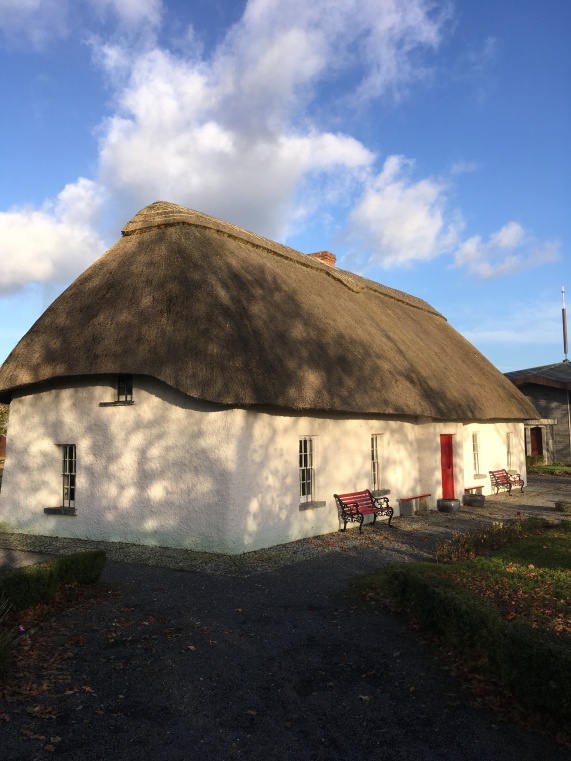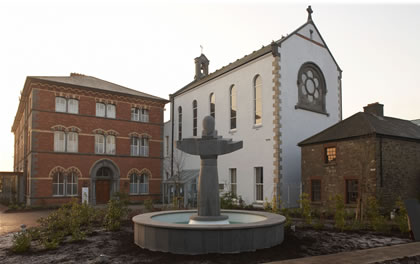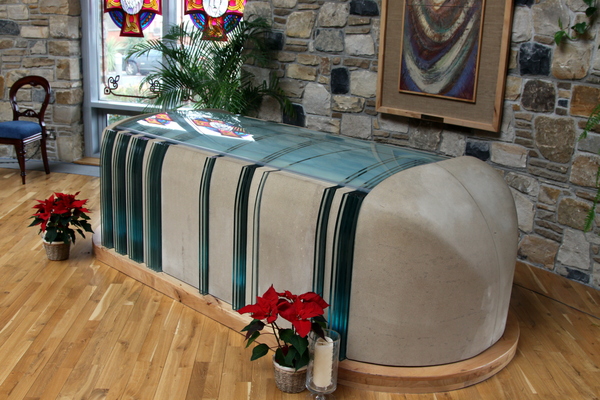Written by: Cathal McGrath.
115328516
For my blog, I am going to shine a light on ‘Blessed’ Edmund Rice who had a massive influence on my local community of Callan, Co. Kilkenny but also the worldwide population. In this Blog i hope to demonstrate my deep understanding of the life of Edmund and the contributions and influences that he has made throughout the four corners of the world.

[Image 1} – Caption: This photo was taken from the main street in Callan, Co. Kilkenny, It gives a detailed description of Edmund Rice’ life and it fittingly shows Edmund having his hand on a young boys shoulder, this picture shows the care and compassion that he had for his pupils.
Edmund was born on the 1st of June 1762 at Westcourt in Callan, Co.Kilkenny, Ireland. He was born into a farming background, under the Penal Laws. He married a woman by the name of Mary Eliot, who at the time was the daughter of a very prosperous Waterford business man. After only three short years of marriage, Mary died shortly after giving birth to a disabled child, which led to Edmund being devastated. Naturally, he went into a period of thought and reflection, but he soon found his calling, which was to provide dignity for the poor through education.

[Image 2]- Caption: This picture shows the birthplace of Edmund Ignatius Rice at Westcourt in Callan, Co.Kilkenny. As you can see the thatched roof on the house has been rejuvenated. The house itself was a six bedroom house consisting of a kitchen, parlour, breakfast room and three bedrooms.
Edmund was said to be a very ambitious man who longed to build a fully fledged Religious Congregation. He took a massive step toward this goal, when in 1802 he commenced the building of a monastery in a working class site at Mount Sion in Waterford City. All the boys who were attending this school were taught useful skills like; reading, writing, arithmetic and religion. Whereas the older pupils were taught in areas like bookkeeping, geography and navigation. All of the boys were given special preparation for when it was their turn to make first Holy Communion and Confirmation. Two decades after the death of Edmund a beautiful monastery was built at Mount Sion in 1864.

[Image 3] – Caption: This image shows the Edmund Rice Heritage Center located at Mount Sion in Waterford City, erected in 1864. It currently serves as a residence for the Christian Brothers and in the picture you can see the monastery and the chapel, and there is also a statue of Edmund with ogham writing.
Edmund and the rest of the brothers worked and prayed together, often sharing their possessions and lives in a community type bond. They all shared a common vision, idea, which was the combination of a semi-monastic life with the hard work of teaching unruly boys who were under ‘primitive’ conditions. The brothers took many vows such as; Poverty, Chastity and Obedience and each o them devoted their lives to the education of poor boys.
Interestingly, every bit of Edmund’s educational input’s were indeed illegal in the eyes of the ‘authorities’ in Ireland at the time. Through the founding of schools and teaching practices, Edmund Rice, like Daniel O’Connell was a liberator. O’Connell had great admiration for Rice and he called him the “patriarch of the monks of the west”.
On the 5th of September 1820, Pope Pius VII approved the Congregation of Christian Brothers, this was a defining moment for the brothers. Within a short period of time, schools were opened in Carrick on Suir, Dungarvan, Cork, Dublin and Kilkenny. Also, schools were opened in England, India, South Africa, Canada and Rome to name just a few. Today, the Brothers of Edmund Rice are working in 30 countries across 5 continents, there are about 272 schools worldwide (ERST.ie, 2017).

{Image 4}- Caption- This is a picture of Kilkenny CBS Secondary school, which is located on James Street in Kilkenny. I attended this school and in my time here I developed my own skills and God-given talents and as a result I became more self-sufficient.
Unfortunately, Edmund died on Thursday, 29th of August 1844. He was buried at Mount Sion in the core of Waterford city. The city of Waterford went into mourning for they felt they lost the greatest ‘benefactor’ (Erst.ie, 2017). It wasn’t until the year 1996, that he was beatified by Pope John Paul the second, where he became renowned as Blessed Edmund Rice.

[Image 5]- Caption: This image shows the tomb of Blessed Edmund Ignatius Rice at Mount Sion, Co. Waterford. The tomb itself sits fantastically on the hill of Mount Sion and looks extremely aesthetically pleasing. As you can see there is Ogham writing on the tomb, which was the ancient Irish alphabet.
To wrap up, I will give a few useful pieces of information from the readings assigned on Blackboard, ‘Material culture’ has operated as a ‘litmus test’ to what is going on right now and what has gone before, spatially and temporally (Kelly, 2009).
Some of the best contemporary geographical work on architecture
explores how meaning, action, and emotion are co-produced
by and through architectural spaces in their attendant
complexity ( (Kraftl, 2009).
References and Bibliography:
Edmundrice.ie. (2017). Edmund Rice International Heritage Centre – Waterford CityEdmund Rice | International Heritage Centres Ltd. [online] Available at: http://edmundrice.ie/ [Accessed 13 Nov. 2017].
(ERST.ie), E. (2017). Our Schools. [online] Edmund Rice Schools Trust (ERST.ie)’. Available at: http://www.erst.ie/our-schools/ [Accessed 13 Nov. 2017].
Erst.ie. (2017). Cite a Website – Cite This For Me. [online] Available at: http://www.erst.ie/uploads/A_Guide_for_Parents.pdf [Accessed 13 Nov. 2017].
(Kelly, T. (2009). Material Culture. International Encyclopedia of Human Geography, pp.Pages 500-504).
Kraftl, P. (2009). Urban Architecture. International Encyclopedia of Human Geography, pp.Pages 24-31.